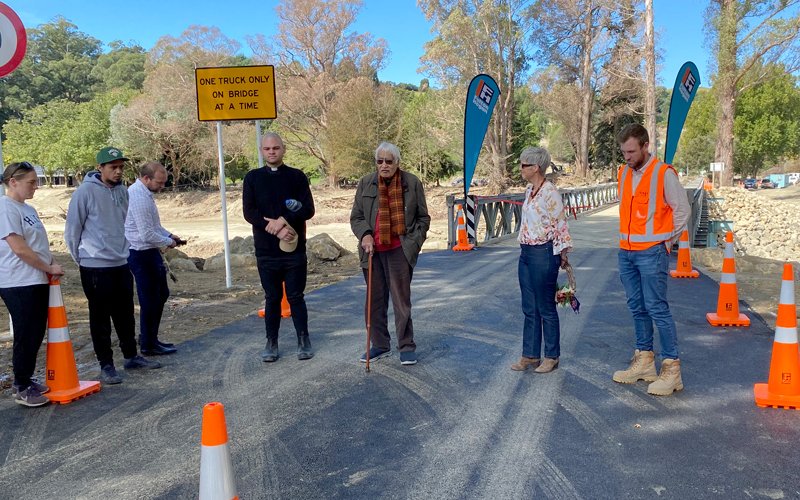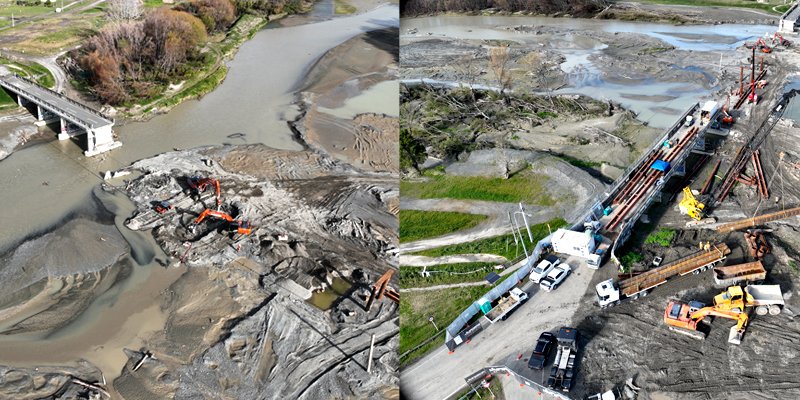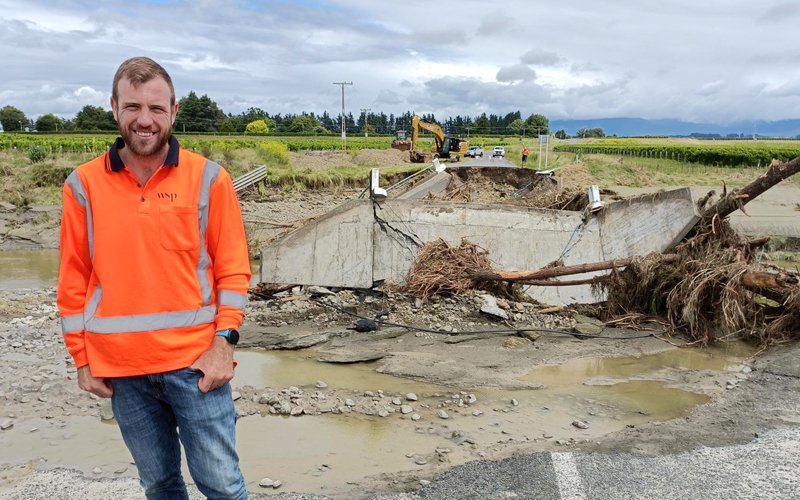20 Jul 2023
Tropical Cyclone Gabrielle was an historic event, causing widespread damage and the tragic loss of 11 lives. As WSP’s seconded Bridge Coordinator for Hastings District Council, Michael Sinclair has had to collaborate with colleagues, contractors, consultants, and the community to restore transport connections damaged or destroyed by the storm.
Michael and his family are relatively new to Napier. So when he and his wife, a clinical nurse manager at Hawkes Bay Hospital, were both needed for the response efforts following Cyclone Gabrielle, the first challenge was figuring out who would watch their son with childcare centres closed.
“We didn’t realise how many friends we had already made over the last couple of years until we were both getting pulled in to help and suddenly all these people were stepping up and offering childcare,” said Michael. “That was quite special – we can’t thank them enough.”

Michael and his son celebrating the completion of the temporary Bailey bridge at Rissington. Photo: Michael Sinclair
Hastings District Council has a panel of consultant engineers, which includes WSP, Stantec and GHD. As part of that panel, Michael’s first role in recovery efforts was to divide the Hastings bridge network into areas of responsibility that best matched each panel-member’s available resources and capabilities.
The result was a colour-coded map tracking the status of each bridge. Black meant the bridge was gone, red meant it was still standing but no longer safe to use, orange meant its use was restricted by factors such as weight or width, and green meant it was safe to use.
This allowed Michael to prioritise response efforts – collaborating with consultants and contractors, adjusting engineering solutions to match available resources, and working with iwi and local communities to reconnect the network.
Some bridges only required minimal works, offering quick wins, but a total of five Bailey bridges and two temporary staging bridges are being installed in the district to reconnect isolated communities. The first became operational on 29 March.
Council has been very clear that they won’t approve anything unless the community is on board, so we’ve been focused on understanding their concerns and working out strategies to address them.
Michael says one of the challenges has been “keeping the community informed and involved with our plans for all bridges in the district, each of which comes with its own challenges. One bridge in particular – the Waiohiki bridge, which is a key link between Taradale and Waiohiki – has included close collaboration with the locals.
“Like many in the region, the Waiohiki community have lost a great deal and are not yet able to return to their homes. They have valid concerns about the dust and disruption that may be caused by the demolition and rebuild process. They’re also worried about the security of their homes.”

Michael attending the ceremony to bless and acknowledge the efforts at the Rissington bridge site, alongside a kaumatua, a priest and other local community leaders. Photo: Michael Sinclair
Security has become intertwined with the rebuild because, with the bridge gone, there is now only one access road into Waiohiki. This has allowed the community to work with local Māori wardens to set up a checkpoint at the entrance to the neighbourhood, mitigating the unfortunate problem of unoccupied, flood-damaged homes being looted.
Once a temporary bridge is built, the resulting through-traffic will make maintaining a checkpoint impractical. Addressing these concerns without delaying the rebuild of a bridge that benefits commuters, the wider community and the local economy requires thoughtful community engagement.
The approach taken by Michael and the Council has been to break the process down into easily digestible steps, so as not to overwhelm the community with too much information at once. They’re also using community meetings and hui with local iwi to ensure the affected parties are heard and included.
“Council has been very clear that they won’t approve anything unless the community is on board, so we’ve been focused on understanding their concerns and working out strategies to address them,” Michael said. “We’re working with the maintenance team on a plan to control the dust, and we’re coordinating with local Police to address security concerns.”
So far, the approach has been successful, with demolition, staging and design work being able to move forward without delay. As each step is undertaken, the community’s concerns regarding the next step are worked through simultaneously.

Waiohiki bridge demolition complete and now progressing with temporary staging bridge. Photo: Michael Sinclair
A recent milestone was a ceremony held at the bridge, where local kaumatua and other community leaders offered karakia and blessings, then spoke on the history and future of the bridge and river. Michael and the engagement team closed out the ceremony by singing Tūtira Mai Ngā Iwi and hosting coffee and breakfast for the group.
“There are still issues we need to address as we move toward a more permanent solution,” Michael said, “but we’re working through them – we’re all on this journey together.”

Michael at the site of the destroyed Matapiro bridge which is now in the feasibility and options report phase for the rebuild. Photo: Michael Sinclair




